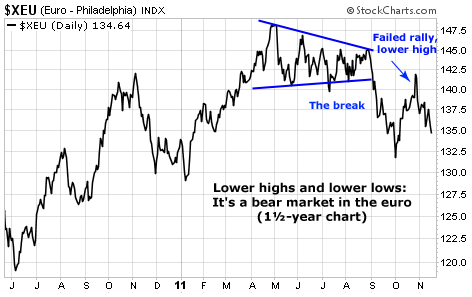| Home | About Us | Resources | Archive | Free Reports | Market Window |
This Simple Strategy Hasn't Lost Money Since the Great DepressionBy
Thursday, November 17, 2011
I love simple investing strategies – the simpler and dumber, the better.
I prefer the simple strategies in part because the history of Wall Street is full of the failures of complicated strategies...
One of the most famous Wall Street failures is Long-Term Capital Management, which was run by two Nobel Prize winners in economics and some Wall Street legends. Its complex mathematical models lost the firm $4.6 billion in less than four months.
So I like to keep it simple. And the strategy I'll share with you today couldn't get any simpler... And yet, since the Great Depression, you never would have lost money by following it.
In the simple strategy I'll explain today, your wealth would have compounded at over 16% a year when this strategy was in "buy" mode since the end of World War II (1945), versus an 11% annual total return for the stock market.
This simple strategy did have a losing stretch during the Great Depression. But so did just about every other stock strategy. And it still beats the pants off the stock market when in buy mode. From 1900 to 1945, the stock market had an annualized total return of only about 7%. But this strategy returned 11% when in buy mode.
So it's easily delivered excellent returns since 1900.
Over history, this strategy has signaled "buy" 42% of the time from 1900 to today... and it's signaled "buy" 37% of the time since 1945. So it's not rare.
Here's all you do...
If one particular thing is true at the end of a month, you buy stocks and hold for the next five years. That's it.
The "one particular thing" that needs to be true is simple. It's the most basic measure of whether stocks are cheap or not – it's the price-to-earnings (P/E) ratio. All that is measuring is the price of stocks over their earnings over the last 12 months.
If you buy when stocks are cheap (at a P/E of 13 or lower) and hold for five years, it's very unlikely you'll lose money. This strategy hasn't lost money since the Great Depression.
Chances are, you haven't heard about this...
The reason you haven't heard about it is simple... With the exception of a brief moment in the recent stock market bust, the last time it signaled was in the 1980s.
But recently, according to Bloomberg, the P/E of the stock market hit 13 again. For the first time since the 1980s, stocks are cheap.
History shows that, if you buy the overall stock market (the S&P 500, which is easy to buy through shares of SPY) at the end of any month when the P/E is less than 13, the total return five years later has always been positive.
You might see different numbers for the P/E ratio. Economist Robert Shiller's ratio, for example, is currently at 21. But as I explained here, extremely low earnings in 2009 knocked Shiller's number out of whack.
In short, by using a different yardstick, stocks might not look as cheap. But history shows using this simple P/E strategy will provide market-beating returns... with very little risk.
When the stock market P/E closes below 13, buy stocks, and hold for the next five years. You wouldn't have lost money in any five-year period since the Great Depression. And since World War II, you would have compounded your wealth at 16%-plus a year when in buy mode.
In short, stocks closed the month of September at a P/E below 13. It's time to buy and hold for five years...
Good investing,
Steve
Further Reading:
If you want stock-like returns without all the volatility, Steve's friend Meb Faber has created a one-click way to generate safe returns. Read more here: An Easy Way to Avoid Volatility... And Still Make Great Returns.
Another one of Steve's systems couldn't be easier to follow... And even better, it would have turned every $10,000 into nearly $64,000 in a little over a decade. Get the full story here: Safe, 500%-Plus Profits Since 1998.
Market NotesIT'S A BEAR MARKET IN THE EURO "Lower highs and lower lows"... that's the new theme for the pan-European currency, the euro. It's also the definition of a bear market.
Some readers wonder why we cover the price action of the euro in our notes. They don't realize Europe is the world's largest economic bloc... even bigger than the United States. What happens with its currency, and its big debt crisis, is just as important as what happens in America.
Back in late August, we highlighted the euro's "compressed" state. This is a situation where an asset's day-to-day volatility gradually dries up and the highs and lows move closer together. These low-volatility periods are often the calm before a storm. We expected to watch the euro's compression resolve itself to the downside.
That downside move came. The euro plummeted from 1.45 to 1.32 (a giant move for a major currency). It then staged a relief rally, which we identified as a good place to short. As you can see, we were right again. The euro's rally took it to a lower high and then broke lower. It is now locked in a series of "lower highs and lower lows..." which is bad news for this important paper currency... and good news for gold owners.
 |
In The Daily Crux
Recent Articles
|


